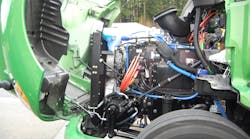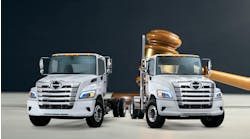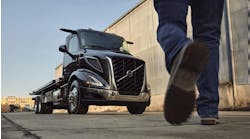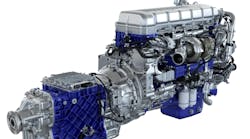Electric truck advantages go beyond zero emissions
No matter what the gross vehicle weight all zero-emissions, or ZE, trucks are electric vehicles with an electric motor, or motors, rather than diesel or another internal combustion engine.
There are some potential advantages to electric propulsion beyond zero emissions. Electric motors have fewer moving parts than diesel and don’t require multi-speed transmissions, which should reduce maintenance costs and improve reliability. They are also quieter, a major advantage in urban applications.
While ZE relies on a single propulsion technology — electrification — there are three different ways to store electrical “fuel” for vehicles, each with its own substantial drawbacks at this early stage of ZE development.
The simplest approach uses batteries. The first commercially available battery-powered trucks are starting to come onto the market, although in very limited numbers. All established truck manufacturers, as well as some highly publicized startups, are showing prototype battery trucks that range from Class 1 vans all the way up to Class 8 tractors.
Advances in battery technology since 2010 have reduced the cost of vehicle storage batteries by 80% and improved energy density by nearly 50%, but the battery arrays needed to provide a practical range for a truck are still costly and bring a large weight penalty compared with diesel. Depending on the application, a battery-powered truck must also be recharged daily, if not more frequently.
Rapid recharge stations, which are expensive, can top off batteries in an hour or two. Less costly plug-in facilities might require eight or more hours, depending on the size of the battery pack. In both cases, trucks have to be scheduled for extended downtimes. And pending legislation to exempt battery weight from GVW calculations, reduced payloads for battery ZE trucks are an issue.
Fuel cell technology produces onboard electric power through a chemical process fueled by hydrogen, potentially mitigating the weight and range issues of batteries. Hydrogen is a plentiful non-carbon fuel, and in liquid form hydrogen refueling times are similar to diesel. Nikola created a major publicity coup by announcing that it would offer a fuel cell Class 8 tractor. And far more quietly, Toyota has partnered with Kenworth to field test fuel cell tractors. Vehicle manufacturers in China are also working on developing fuel cell systems that can be mass produced at a lower cost.
Even with large investments in research over the last 20 years, vehicle fuel cells are still a work in progress. Current hardware costs are high but might reasonably be expected to come down with production volumes. However, building a fuel cell compact enough and rugged enough for daily duty in a working truck requires more development work. While the onboard technology is getting closer to a practical form, refilling truck hydrogen tanks presents a more serious challenge. An extensive electric grid already exists to bring power to battery recharging stations, but no similar infrastructure exists for delivering hydrogen to accessible refueling stations.
The third approach to electrifying a truck generates electric power onboard to augment a diesel or other traditional engine. Stored in a small battery pack, the generated electric energy can be used to drive a truck’s wheels under limited circumstances such as start-up or within urban areas, with the diesel taking over for longer range. Alternatively, a small generator driven off the diesel or driveline can electrically power accessories like air conditioning and hotel services to reduce parasitic loads and improve fuel efficiency. Compared to plug-in battery technology, both hybrid approaches reduce the battery weight penalty and eliminate range limitations. Also, both are market ready.
The drawback to hybrids is they still require exhaust aftertreatment systems in addition to a separate electrical motor or generator and storage batteries. That adds both cost and complexity, as well as a weight penalty compared to a simple diesel powertrain.
Just to confuse things a bit more, there’s another category of trucks that are near-ZE. Essentially natural gas propulsion, they have exceeding low air quality emissions, even today meeting the EPA’s proposed 0.02 g/php-hr. NOx limit. While lower than diesel, NG trucks still have GHG emissions, at least when measured at the tailpipe. Companies like Clean Energy, however, point out that using renewable natural gas made from waste goes beyond ZE to deliver an actual reduction in overall CO2 creation. The company also argues that such a near-ZE truck approach is already well developed and available today to address emissions concerns.
This week, we’re taking a deeper look at the future of ZE truck technologies. We’ll look at which technology might win out later this week.



